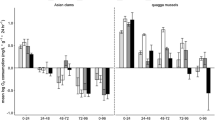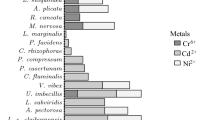Abstract
Growing human populations and increasingly intensive agriculture have resulted in widespread aquatic nitrate pollution. Freshwater mussel populations have been in decline for decades but often are underrepresented in data used for the development of ambient water quality criteria and acute toxicity of nitrate to mussel glochidia has not yet been established. Additionally, toxicity testing with aquatic species often is limited to a few model species; however, relatively little is known about how representative model species are of imperiled species. Therefore, to better define the acute toxicity of nitrate to common and rare aquatic species, we conducted 24-h nitrate acute toxicity tests with glochidia of four species of freshwater mussels, including a federally threatened species (Hamiota altilis) and 7-day tests with larval fish of three species: fathead minnow (Pimephales promelas), tricolor shiner (Cyprinella trichroistia), and tilapia (Oreochromis spp.), across a range of water hardness. Median effective concentrations (EC50s) in freshwater mussel glochidia ranged from 524 to 904 mg/L NO3–N in moderately hard water. In fish, median lethal concentrations (LC50s) ranged from 228 to 1725 mg/L NO3–N and varied with water hardness. Of the species tested, generally sensitivity of the common species was similar to the rare species, although relative sensitivity varied with water hardness. Based on these results, we can conclude that acute lethal effects are unlikely for the fish and mussel species considered here at current environmental levels, but the results of these standardized tests are useful for the development of ambient water quality criteria and other regulatory and management decisions regarding acute nitrate exposures.



Similar content being viewed by others
References
Adelman IR, Kusilek LI, Koehle J, Hess J (2009) Acute and chronic toxicity of ammonia, nitrite, and nitrate to the endangered Topeka shiner (Noptropis topeka) and fathead minnows (Pimephales promelas). Environ Toxicol Chem 28:2216–2223. https://doi.org/10.1897/08-619.S1
American Society for Testing and Materials (ASTM) (2013) Standard guide for conducting laboratory toxicity tests with freshwater mussels. E2455-06. In: Annual book of ASTM Standards, vol 11.06. ASTM International, West Conshohocken, PA. www.astm.org
Ankley GT, Villeneuve DL (2006) The fathead minnow in aquatic toxicology: past, present and future. Aquat Toxicol 78:91–102. https://doi.org/10.1016/j.aquatox.2006.01.018
Baker JA, Gilron G, Chalmers BA, Elphick JR (2017) Evaluation of the effect of water type on the toxicity of nitrate to aquatic organisms. Chemosphere 168:435–440. https://doi.org/10.1016/j.chemosphere.2016.10.059
Borgmann U, Couillard Y, Doyle P, Dixon DG (2005) Toxicity of sixty three metals and metalloids to Hyalella azteca at two levels of water hardness. Environ Toxicol Chem 24:641–652. https://doi.org/10.1897/04-177R.1
Bringolf RB, Cope WG, Barnhart MC et al (2007a) Acute and chronic toxicity of pesticide formulations (Atrazine, Chlorpyrifos, and Permethrin) to glochidia and juveniles of Lampsilis siliquoidea. Environ Toxicol Chem 26:2101–2107. https://doi.org/10.1897/06-555R.1
Bringolf RB, Cope WG, Eads CB et al (2007b) Acute and chronic toxicity of technical-grade pesticides to glochidia and juveniles of freshwater mussels (Unionidae). Environ Toxicol Chem 26:2086–2093. https://doi.org/10.1897/06-522R.1
Bringolf RB, Cope WG, Mosher S et al (2007c) Acute and chronic toxicity of glyphosate compounds to glochidia and juveniles of Lampsilis siliquoidea (Unionidae). Environ Toxicol Chem 26:2094–2100. https://doi.org/10.1897/06-519R1.1
Calamari D, Marchetti R, Vailati G (1980) Influence of water hardness on cadmium toxicity to Salmo gairdneri rich. Water Res 14:1421–1426. https://doi.org/10.1016/0043-1354(80)90006-8
Camargo JA, Ward JV (1992) Short-term toxicity of sodium nitrate (NaNO3) to non-target freshwater invertebrates. Chemosphere 24:23–28. https://doi.org/10.1016/0045-6535(92)90563-7
Camargo JA, Alonsa A, Salamanca A et al (2005) Nitrate toxicity to aquatic animals: a review with new data for freshwater invertebrates. Chemosphere 58:1255–1267. https://doi.org/10.1016/j.chemosphere.2004.10.044
Cherry DS, Van Hassel JH, Farris JL et al (2002) Site-specific derivation of the acute copper criteria for the Clinch River, Virginia. Hum Ecol Risk Assess 8:591–601. https://doi.org/10.1080/20028091057097
Colt J, Tchobanoglous G (1976) Evaluation of the short-term toxicity of nitrogenous compounds to channel catfish, Ictalurus punctatus. Aquaculture 8:209–224. https://doi.org/10.1016/0044-8486(76)90084-3
Cope WG, Bringolf RB, Buchwalter DB et al (2008) Differential exposure, duration, and sensitivity of unionoidean bivalve life stages to environmental contaminants. J N Am Benthol Soc 27:451–462. https://doi.org/10.1899/07-094.1
Cummings K, Cordeiro J (2012a) Hamiota altilis. The IUCN red list of threatened species 2012:e.T11250A502085. https://doi.org/10.2305/IUCN.UK.2012-1.RLTS.T11250A502085.en. Accessed 22 Mar 2019
Cummings K, Cordeiro J (2012b) Lampsilis siliquoidea. The IUCN red list of threatened species 2012:e.T189448A1926029. https://doi.org/10.2305/IUCN.UK.2012-1.RLTS.T189448A1926029.en. Accessed 22 Mar 2019
Cummings K, Cordeiro J (2012c) Lampsilis fasciola. The IUCN red list of threatened species 2012:e.T189279A1922805. https://doi.org/10.2305/IUCN.UK.2012-1.RLTS.T189279A1922805.en. Accessed 22 Mar 2019
Doherty FG (1983) Interspecies correlations of acute aquatic median lethal concentration for four standard testing species. Environ Sci Technol 17:661–665. https://doi.org/10.1021/es00117a007
Douda K (2010) Effects of nitrate nitrogen pollution on Central European unionid bivalves revealed by distributional data and acute toxicity testing. Aquat Conserv Mar Freshw Ecosyst 20:189–197. https://doi.org/10.1002/aqc
Dowden BF, Bennett HJ (1965) Toxicity of selected chemicals to certain animals. J Water Pollut Control Fed 37:1308–1316
Elonen GE, Spehar RL, Holcombe GW et al (1998) Comparative toxicity of 2,3,7,8-tetrachlorodibenzo-p-dioxin to seven freshwater fish species during early life-stage development. Environ Toxicol Chem 17:472–483. https://doi.org/10.1002/etc.5620170319
Erickson RJ (2015) Toxicity relationship analysis program (TRAP) version 1.30. U.S. Environmental Protection Agency, Washington
Erickson RJ, Van Hassel JH (eds) (2007) Freshwater bivalve ecotoxicology. CRC Press, Pensacola. ISBN 978-0-367-38989-5
Fujimura K, Okada N (2007) Development of the embryo, larva and early juvenile of Nile tilapia Oreochromis niloticus (Pisces: Cichlidae). Developmental staging system. Dev Growth Differ 49:301–324. https://doi.org/10.1111/j.1440-169X.2007.00926.x
Gama J (2015) Ecotoxicology: methods for ecotoxicology. R Package version 1.0.1. https://CRAN.R-project.org/package=ecotoxicology. Accessed 16 Feb 2018
Gilroy ÈM, Klinck JS, Campbell SD et al (2014) Toxicity and bioconcentration of the pharmaceuticals moxifloxacin, rosuvastatin, and drospirenone to the unionid mussel Lampsilis siliquoidea. Sci Total Environ 487:537–544. https://doi.org/10.1016/j.scitotenv.2014.03.051
Haag WR (2012) North American freshwater mussels: natural history, ecology, and conservation. Cambridge University Press, Cambridge. ISBN 978-0-521-19938-4
Iowa Department of Natural Resources (2017) Iowa STORET/WQX Water Quality Database. https://programs.iowadnr.gov/iastoret/. Accessed 26 Jan 2017
Jorge MB, Loro VL, Bianchini A et al (2013) Mortality, bioaccumulation and physiological responses in juvenile freshwater mussels (Lampsilis siliquoidea) chronically exposed to copper. Aquat Toxicol 126:137–147. https://doi.org/10.1016/j.aquatox.2012.10.014
Keller AE, Ruessler DS (1997) The toxicity of malathion to unionid mussels: relationship to expected environmental concentrations. Environ Toxicol Chem 16:1028–1033. https://doi.org/10.1002/etc.5620160524
Kincheloe JW, Wedemeyer GA, Koch DL (1979) Tolerance of developing salmonid eggs and fry to nitrate exposure. Bull Environ Contam Toxicol 23:575–578. https://doi.org/10.1007/BF01770006
Miao J, Barnhart MC, Brunson EL et al (2010) An evaluation of the influence of substrate on the response of juvenile freshwater mussels (fatmucket, Lampsilis siliquoidea) in acute water exposures to ammonia. Environ Toxicol Chem 29:2112–2116. https://doi.org/10.1002/etc.259
Newton TJ, Allran JW, O’Donnell JA et al (2003) Effects of ammonia on juvenile unionid mussels (Lampsilis cardium) in laboratory sediment toxicity tests. Environ Toxicol Chem 22:2554–2560. https://doi.org/10.1897/02-342
Pascoe D, Evans SA, Woodworth J (1986) Heavy metal toxicity to fish and the influence of water hardness. Arch Environ Contam Toxicol 15:481–487. https://doi.org/10.1007/BF01056559
Poulsen R, Cedergreen N, Hayes T, Hansen M (2018) Nitrate: an environmental endocrine disruptor? A review of evidence and research needs. Environ Sci Technol. https://doi.org/10.1021/acs.est.7b06419
R Core Team (2013) R: a language and environment for statistical computing. R Foundation for Statistical Computing, Vienna
Raimondo S, Lilavois CR, Lee L et al (2016) Assessing variability in chemical acute toxicity of unionid mussels: influence of intra- and interlaboratory testing, life stage, and species. Environ Toxicol Chem 35:750–758. https://doi.org/10.1002/etc.3245
Schuytema GS, Nebeker AV (1999) Comparative effects of ammonium and nitrate compounds on Pacific treefrog and African clawed frog embryos. Arch Environ Contam Toxicol 36:200–206. https://doi.org/10.1007/s002449900461
Scott G, Crunkilton RL (2000) Acute and chronic toxicity of nitrate to fathead minnows (Pimephales promelas), Ceriodaphnia dubia, and Daphnia magna. Environ Toxicol Chem 19:2918–2922. https://doi.org/10.1002/etc.5620191211
Smith ME, Lazorchak JM, Herrin LE et al (1997) A reformulated, reconstituted water for testing the freshwater amphipod, Hyalella azteca. Environ Toxicol 16:1229–1233. https://doi.org/10.1002/etc.5620160618
Soucek DJ, Dickinson A (2012) Acute toxicity of nitrate and nitrite to sensitive freshwater insects, mollusks, and a crustacean. Arch Environ Contam Toxicol 62:233–242. https://doi.org/10.1007/s00244-011-9705-8
Strayer DL, Downing JA, Haag WR et al (2004) Changing perspectives on Pearly Mussels, North America’s most imperiled animals. Bioscience 54:429–439. https://doi.org/10.1641/0006-3568(2004)054%5b0429:cpopmn%5d2.0.co;2
Thurston RV, Gilfoil TA, Meyn EL et al (1985) Comparative toxicity of ten organic chemicals to ten common aquatic species. Water Res 19:1145–1155. https://doi.org/10.1016/0043-1354(85)90351-3
Tomasso JR, Carmichael GJ (1986) Acute toxicity of ammonia, nitrite, and nitrate to the Guadalupe bass, Micropterus treculi. Bull Environ Contam Toxicol 36:866–870. https://doi.org/10.1007/BF01623596
Trama FB (1954) The acute toxicity of some common salts of sodium, potassium and calcium to the common bluegill (Lepomis macrochirus Rafinesque). Proc Acad Nat Sci Phila 106:185–205
United States Environmental Protection Agency (2002) Methods for measuring the acute toxicity of effluents and receiving waters to freshwater and marine organisms, 5th edn. EPA-821-R-02-012, Washington
United States Environmental Protection Agency (2009) National drinking water regulations. EPA 816-F-09-004, Washington
Vitousek PM, Aber JD, Howarth RH et al (1997) Human alteration of the global nitrogen cycle: source and consequences. Ecol Appl 7:737–750. https://doi.org/10.1038/nn1891
Wang N, Ingersoll CG, Hardesty DK et al (2007) Acute toxicity of copper, ammonia, and chlorine to glochidia and juveniles of freshwater mussels (Unionidae). Environ Toxicol Chem 26:2036–2047. https://doi.org/10.1897/06-523R.1
Wang N, Ivey CD, Ingersoll CG et al (2017) Acute sensitivity of a broad range of freshwater mussels to chemicals with different modes of toxic action. Environ Toxicol Chem 36:786–796. https://doi.org/10.1002/etc.3642
Westin DT (1974) Nitrate and nitrite toxicity to salmonoid fishes. Prog Fish Cult 36:86. https://doi.org/10.1577/1548-8659(1974)36%5b86:nantts%5d2.0.co;2
Williams JD, Warren ML Jr, Cummings KS et al (1993) Conservation status of freshwater mussels of the United States and Canada. Fisheries 18:6–22. https://doi.org/10.1577/1548-8446(1993)018%3c0006:CSOFMO%3e2.0.CO;2
Acknowledgements
Funding for this project was provided by a U.S. Fish and Wildlife Service Science Support Partnership with the U.S. Geological Survey through Cooperative Agreement No. G15AC00213 at the University of Georgia. Assistantship support for A.P.M. was provided by the University of Georgia Interdisciplinary Toxicology Program and the Warnell School of Forestry and Natural Resources at the University of Georgia via the National Institute of Food and Agriculture. Mussels used in these experiments were generously provided by Dr. Paul Johnson and the staff at the Alabama Aquatic Biodiversity Center, Dr. Chris Barnhart at the University of Missouri, and Dr. Jim Stoeckel at Auburn University. The authors thank Bob Ratajczak for his assistance in the collection of fish and execution of this study. This study was conducted under the auspices of the University of Georgia Animal Use Protocol No. A2016 06-030-Y2-A2.
Author information
Authors and Affiliations
Corresponding author
Electronic supplementary material
Below is the link to the electronic supplementary material.
Rights and permissions
About this article
Cite this article
Moore, A.P., Bringolf, R.B. Comparative Toxicity of Nitrate to Common and Imperiled Freshwater Mussel Glochidia and Larval Fishes. Arch Environ Contam Toxicol 78, 536–544 (2020). https://doi.org/10.1007/s00244-020-00708-z
Received:
Accepted:
Published:
Issue Date:
DOI: https://doi.org/10.1007/s00244-020-00708-z




